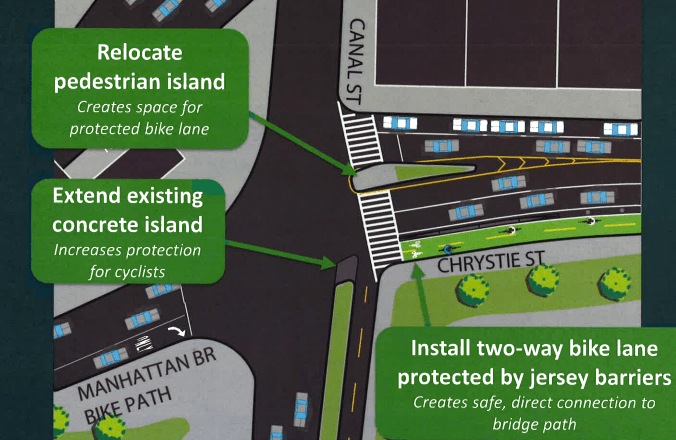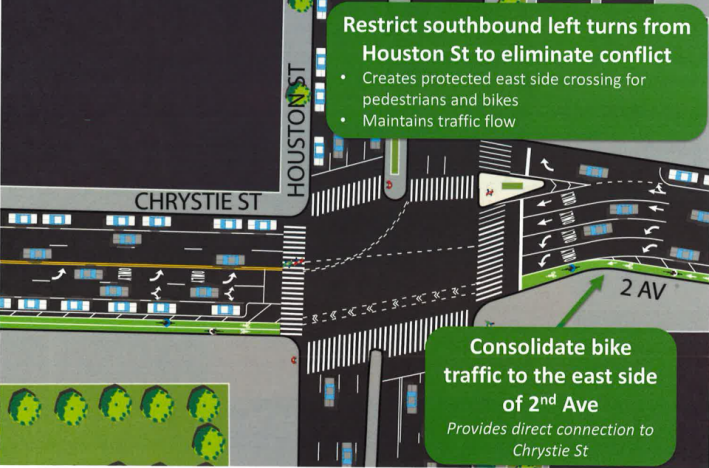
DOT unveiled its plan for a two-way protected bike lane on Chrystie Street last night [PDF], a project that promises to drastically improve safety and reduce stress for people biking to and from the Manhattan Bridge.
Chrystie Street is one of the most important bike routes in the city. On average, more than 6,200 cyclists ride over the Manhattan Bridge each day from April through October, according to DOT, and Chrystie Street is the key connection between the bridge and the First and Second Avenue protected bike lanes. Last July, DOT counted nearly 3,000 daily cyclists riding on Chrystie Street between 7 a.m. and 9 p.m.
DOT painted bike lanes on both sides of Chrystie in 2008, but it's a treacherous ride: Cyclists are often forced to weave in and out of car traffic to avoid illegally parked vehicles. Last year, 16 cyclists and 14 pedestrians were injured within the project area.
Volunteers with Transportation Alternatives have pushed for a redesign of Chrystie for more than a year. In 2015, a design concept for a protected bike lane by Dave "Paco" Abraham won the support of Manhattan Community Board 3 and nearly every elected official who represents the area.
DOT presented its plan for Chrystie to the CB 3 transportation committee last night. It calls for a two-way protected bike lane along Sara D. Roosevelt Park from Canal Street to Houston Street. The two-way path will have a three-foot buffer, and the combined travel lanes for bikes will vary between eight feet and nine feet wide, depending on the total width of the street. To align with the new Chrystie bikeway, the southbound bike lane on Second Avenue will be shifted over to the east side of the street for the two blocks between 2nd Street and Houston.

The plans also includes four concrete pedestrian islands, two at Stanton Street and one apiece at Rivington Street and 2nd Street.
To eliminate conflicts between turning drivers and cyclists at the intersections with Delancey Street and Houston Street, DOT plans to install signals that restrict left turns from southbound Chrystie while cyclists have a green light. Left turns from northbound Chrystie onto Delancey would also be banned, and sidewalks would be extended at three corners of that intersection.
About 20 members of the public spoke at last night’s meeting, and nearly all expressed support for the proposal. The committee seemed poised to approve it unconditionally until District Manager Susan Stetzer latched onto comments from Kathleen Webber of the Sara D Roosevelt Park Coalition about whether the city had reached out to seniors and visually-impaired neighborhood residents. CB 3's resolution from last year asked DOT to consult those constituencies.
The committee ended up unanimously approving the Chrystie Street plan on the condition that DOT hold a public meeting in coordination with the Sara D Roosevelt Park Coalition.
In April or May, DOT will come back to the community board for approval of the “final design,” which is not likely to change much from what was presented last night.
“In order to make sure that it passes at full board, we have to make sure that you guys talk to all the relevant groups that need to hear this,” Committee Chair Karen Blatt told the DOT representatives in the room.
DOT Manhattan community liaison Colleen Chattergoon told Blatt that the extended process would not delay implementation, which is scheduled for the fall.






